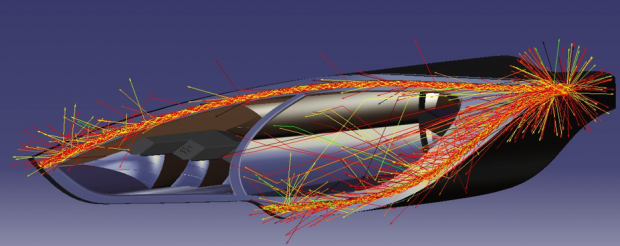
OPTIS has released the 2018 edition of its SPEOS light simulation software. Image courtesy of OPTIS.
Latest News
March 14, 2018
 Dear DE Reader:
Dear DE Reader:
Stephen Hawking died today. He'd likely be amused that many of us learned of his passing on Pi Day late yesterday. The physics of time travel at the speed of light were among Hawking's many theoretical pursuits. For many of you, working with the physics of light is a daily, hands-on pursuit. Today's Editor's Pick of the Week takes a look at simulation software for working with light.
Virtual prototyping is what OPTIS is all about. Their expertise lies in light and human vision simulation integrated with mechanical design software like CATIA, NX, PTC Creo and SOLIDWORKS as well as immersive reality design. The company just released SPEOS 2018, its core CAD-integrated light simulation software. This release has lots of goodies for automotive optics engineers. Here's a peek.
 OPTIS has released the 2018 edition of its SPEOS light simulation software. Image courtesy of OPTIS.
OPTIS has released the 2018 edition of its SPEOS light simulation software. Image courtesy of OPTIS.SPEOS 2018 now incorporates a mode that's described as intended to push the limits of the visible distance and width of headlight beams while maintaining regulatory compliance, according to OPTIS. It now also includes the ability to simulate solid-state LiDAR (light detection and ranging) technology.
Another new functionality gives you the ability to make optical free-form surfaces. Now you can also execute analyses of head-up display (HUD) optical systems. This includes help for defining your HUD windshield testing device and a digital light processing library dedicated to HUD in automotive applications.
Complementary to that is a new dedicated test for the emergent SAE J1757-2 optical metrology standard for automotive HUD. The SPEOS HUD Optical Analysis enables optics engineers at an OEM to implement their own HUD requirements and generate reports in accordance with the SAE standard automatically.
In addition to algorithmic enhancements to boost overall efficiency, SPEOS 2018 debuts functionality to generate ray files in the industry-standard IES TM-25 format, which describes the emission properties of light sources. You can now also measure and certify illumination on the fly.
On a side note. OPTIS also released SPEOS Lighting for SOLIDWORKS. It gives you capabilities for testing and validating the ergonomics of the future product in virtual reality. This version is tailored more for lighting industry applications, including architecture.
SPEOS 2018 is about way more than generating snazzy pictures of your designs and mock-ups, although it renders awesome imagery. It's even more than understanding and optimizing how light interacts with your mechanical geometries. It's ergonomics, safety, compliance, better products as well as aesthetics. Hit today's link to be enlightened by this intriguing tool.
Thanks, Pal. – Lockwood
Anthony J. Lockwood
Editor at Large, DE
Subscribe to our FREE magazine, FREE email newsletters or both!
Latest News
About the Author
Anthony J. Lockwood is Digital Engineering’s founding editor. He is now retired. Contact him via [email protected].
Follow DE





